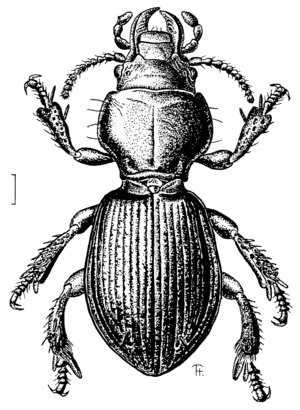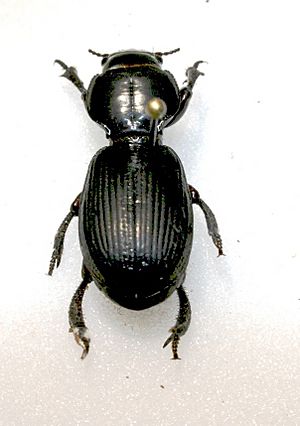Brullea facts for kids
Quick facts for kids Mecodema antarctica |
|
|---|---|
 |
|
| Illustration by Tony Harris | |
| Scientific classification | |
| Kingdom: | |
| Phylum: | |
| Class: | |
| Order: | |
| Suborder: | |
| Family: | |
| Genus: |
Mecodema
Castelnau, 1867
|
| Species: |
M. antarctica
|
| Binomial name | |
| Mecodema antarctica Castelnau, 1867
|
|
Mecodema antarctica is a special type of ground beetle that eats other small creatures. It's the only species in its group, and it loves to dig in the sand on New Zealand beaches, usually above where the waves reach. Scientists first described this beetle in 1867.
What it Looks Like
Mecodema antarctica is a large beetle, growing up to 25 millimeters long. It has a smooth, shiny body that can be reddish-brown or black. Like all Mecodema beetles, it has a clear "waist" or narrow part between its main body sections.
Recent DNA studies show that this beetle belongs to the Mecodema group. Its unique body shape, which is different from other Mecodema beetles, helps it burrow easily in the sand.
Special Body Parts
This beetle's legs are perfectly designed for digging in sand. Its upper leg parts (coxa, femur, and tibia) are very wide. All its lower leg parts (tibia) are greatly expanded at their ends. The middle and back pairs of legs are also strongly curved, which helps with digging.
Other features that help it live in the sand include short antennae and large, curved jaws (mandibles). Its body shape is quite boxy, unlike the longer, more slender Mecodema species that live in forests. The belly of M. antarctica is covered in long, stiff hairs (setae). These hairs protect it from getting scratched by the sand.
For a long time, scientists didn't know what the young (larval) form of this beetle looked like. It was finally described in 1978.
Where it Lives

Mecodema antarctica lives in the splash zone of sandy beaches around the New Zealand coast. This is the area just above the high tide mark, where waves sometimes reach. During the day, it hides in the sand or under logs and stones. At night, it comes out to find food.
The entomologist George Hudson once said this beetle was "usually rare." However, because it's a secretive beetle that burrows, it can be hard to find. Sometimes, many of them are discovered at once. For example, in 2006, schoolchildren rediscovered it on the Whanganui coast. It hadn't been seen there for many years before that.
Threats to the Beetle
Mecodema antarctica is sometimes eaten by katipō spiders. It might also be in danger from an introduced spider from South Africa called Steatoda capensis. This new spider could either eat the beetle or compete with it for food and space.
See also
 In Spanish: Mecodema para niños
In Spanish: Mecodema para niños

